Please download PDF from the button above for all other contents for the following currencies.
Australian dollar // New Zealand dollar //Canadian dollar // Norwegian krone // Swedish Krona // Swiss franc // Czech koruna // Hungarian forint //Polish zloty // Romanian leu // Russian rouble // South African rand // Turkish lira // Indian rupee // Indonesian rupiah // Malaysian ringgit // Philippine peso //Singapore dollar // South Korean won // Taiwan dollar // Thai baht // Vietnamese dong // Argentine peso // Brazilian real // Chilean peso // Mexican peso // Crude oil // Saudi riyal // Egyptian pound
Monthly Foreign Exchange Outlook
DEREK HALPENNY
Head of Research, Global Markets EMEA and International Securities
Global Markets Research
Global Markets Division for EMEA
E: derek.halpenny@uk.mufg.jp
LEE HARDMAN
Senior Currency Analyst
Global Markets Research
Global Markets Division for EMEA
E: lee.hardman@uk.mufg.jp
LIN LI
Head of Global Markets Research Asia
Global Markets Research
Global Markets Division for Asia
E: lin_li@hk.mufg.jp
MICHAEL WAN
Senior Currency Analyst
Global Markets Research
Global Markets Division for Asia
E: michael_wan@sg.mufg.jp
EHSAN KHOMAN
Head of Commodities, ESG and Emerging Markets Research – EMEA
DIFC Branch – Dubai
E: ehsan.khoman@ae.mufg.jp
CARLOS PEDROSO
Chief Economist
Banco MUFG Brasil S.A.
E: cpedroso@br.mufg.jp
MAURICIO NAKAHODO
Senior Economist
Banco MUFG Brasil S.A.
E: mnakahodo@br.mufg.jp
MUFG Bank, Ltd.
A member of MUFG, a global financial group
September 2023
KEY EVENTS IN THE MONTH AHEAD
1) MORE PAUSES, FEWER HIKES?
The US dollar rebounded notably in August, by 1.7% on a DXY basis with US economic resilience lifting yields back toward cyclical highs. We have raised our US dollar forecasts for Q3 and Q4 but maintain a weaker dollar profile in H1 2024. Evidence of weak economic data has been delayed but we maintain our view of rate cuts from the Fed in 2024 (now 100bps in H1 2024). September is likely to be an important month for the financial markets with nine of the G10 central banks holding policy meetings (RBNZ is not meeting). For the first time since the inflation surge began in Q1 2022 we are likely to see the majority of G10 central banks keeping policy rates on hold. The Fed we believe will hold as will the RBA and the BoC. We expect the ECB to hold but acknowledge that is more finely balanced as is the decision from the SNB. The Riksbank, Norges bank and the Bank of England are likely to hike again but we believe that will be the last for the BoE. The end of tightening cycles are in sight and the market focus will increasingly shift away from inflation angst and toward concerns over economic growth.
2) SEPTEMBER CAN MEAN VOLATILITY
The seasonal pattern for the S&P 500 covering 25 years of equity market performance data highlights August and September as the two most challenging months of the year. The S&P 500 fell 1.8% in August so is following the historic pattern so far. Developments to monitor in September that could undermine equity sentiment include China property market developments of course but also some tentative signs of food and energy prices picking up. Natural gas prices in Europe had a volatile month in August while the Black Sea gain deal ensuring supply of grains from Ukraine continues has broken down. India has banned the export of non-basmati rice while El Nino is expected to negative impact crop yields over the coming months. OPEC+ is reported to be considering another production cut. Signs of higher inflation emerging again just as central banks move to pause could undermine investor confidence. We may also see the US move toward another government shutdown if a deal in Congress on a funding stopgap is not reached by month-end.
3) EXPECT SOME STABILIZATION IN SENTIMENT ABOUT PROPERTY SECTOR
Guangzhou became the first major Chinese city to ease mortgage restrictions, with the city government announcing on 30th August that it will allow homebuyers to enjoy preferential loans for first-home purchases regardless of their previous credit record. That came after the PBOC and two other authorities issued a circular on 25th August promoting the implementation of the mortgage policies, while the Ministry of Finance also announced the extension of favourable tax policies for homebuyers. We expect more Chinese local cities to follow suit.
Forecast rates against the US dollar - End-3 2023 to End-Q2 2024
|
Spot close 31.08.23 |
Q3 2023 |
Q4 2023 |
Q1 2024 |
Q2 2024 |
|
|
JPY |
145.70 |
145.00 |
145.00 |
138.00 |
136.00 |
|
EUR |
1.0844 |
1.0700 |
1.0800 |
1.1000 |
1.1200 |
|
GBP |
1.2667 |
1.2510 |
1.2490 |
1.2640 |
1.2660 |
|
CNY |
7.2583 |
7.2000 |
7.1000 |
6.9000 |
6.8000 |
|
AUD |
0.6466 |
0.6350 |
0.6400 |
0.6500 |
0.6700 |
|
NZD |
0.5945 |
0.5800 |
0.5850 |
0.6000 |
0.6100 |
|
CAD |
1.3546 |
1.3700 |
1.3500 |
1.3300 |
1.3200 |
|
NOK |
10.660 |
10.841 |
10.5560 |
10.1820 |
9.8210 |
|
SEK |
10.950 |
11.121 |
10.833 |
10.455 |
10.179 |
|
CHF |
0.8842 |
0.8880 |
0.8840 |
0.8770 |
0.8660 |
|
|
|
|
|
|
|
|
CZK |
22.197 |
22.620 |
22.590 |
22.360 |
22.050 |
|
HUF |
351.77 |
359.80 |
365.70 |
363.60 |
361.60 |
|
PLN |
4.1209 |
4.1590 |
4.1670 |
4.1360 |
4.1070 |
|
RON |
4.5549 |
4.6260 |
4.6020 |
4.5450 |
4.5000 |
|
RUB |
95.339 |
98.890 |
101.350 |
103.350 |
104.360 |
|
ZAR |
18.911 |
18.750 |
19.000 |
19.250 |
19.250 |
|
TRY |
26.680 |
27.500 |
28.500 |
29.250 |
30.000 |
|
|
|
|
|
|
|
|
INR |
82.780 |
82.700 |
82.000 |
81.500 |
81.000 |
|
IDR |
15225 |
15200 |
15100 |
14900 |
14800 |
|
MYR |
4.6365 |
4.5500 |
4.4500 |
4.3500 |
4.2500 |
|
PHP |
56.574 |
56.700 |
56.200 |
55.500 |
55.200 |
|
SGD |
1.3517 |
1.3500 |
1.3400 |
1.3200 |
1.3100 |
|
KRW |
1322.7 |
1300.0 |
1280.0 |
1250.0 |
1220.0 |
|
TWD |
31.869 |
31.600 |
31.400 |
31.000 |
30.600 |
|
THB |
34.990 |
34.800 |
34.500 |
34.000 |
33.500 |
|
VND |
24084 |
24300 |
24250 |
24100 |
24000 |
|
|
|
|
|
|
|
|
ARS |
349.99 |
350.00 |
400.00 |
490.00 |
600.00 |
|
BRL |
4.9449 |
4.9000 |
5.2000 |
5.2200 |
5.2500 |
|
CLP |
855.43 |
860.00 |
865.00 |
840.00 |
820.00 |
|
MXN |
16.921 |
16.750 |
17.100 |
17.300 |
17.600 |
|
|
|||||
|
Brent |
86.65 |
80.00 |
84.00 |
83.00 |
81.00 |
|
NYMEX |
82.60 |
76.00 |
79.00 |
78.00 |
77.00 |
|
SAR |
3.7507 |
3.7500 |
3.7500 |
3.7500 |
3.7500 |
|
EGP |
30.910 |
32.200 |
32.500 |
33.900 |
34.800 |
Notes: All FX rates are expressed as units of currency per US dollar bar EUR, GBP, AUD and NZD which are expressed as dollars per unit of currency. Data source spot close; Bloomberg closing rate as of 4:30pm London time, except VND which is local onshore closing rate.
US dollar
|
Spot close 31.08.23 |
Q3 2023 |
Q4 2023 |
Q1 2024 |
Q2 2024 |
|
|
USD/JPY |
145.70 |
145.00 |
145.00 |
138.00 |
136.00 |
|
EUR/USD |
1.0844 |
1.0700 |
1.0800 |
1.1000 |
1.1200 |
|
Range |
Range |
Range |
Range |
||
|
USD/JPY |
140.00-151.00 |
138.00-152.00 |
132.00-148.00 |
130.00-146.00 |
|
|
EUR/USD |
1.0500-1.1200 |
1.0500-1.1300 |
1.0600-1.1400 |
1.0700-1.1600 |
MARKET UPDATE
In August the US dollar strengthened against the euro in terms of London closing rates, moving from 1.1028 to 1.0844. In addition, the dollar strengthened versus the yen, from 142.13 to 145.70. The FOMC did not meet in August and hence the fed funds rate was unchanged between 5.25% and 5.50%. The FOMC has continued with its policy of reducing its securities holdings with QT ongoing at a pace of USD 95bn worth of UST bonds (USD 60bn) and MBS (USD 35bn) of balance sheet reduction each month. The balance sheet has now shrunk to USD 8,139bn, down USD 826bn from the peak in April 2022.
OUTLOOK
The US dollar strengthened in August after hitting year-to-date lows in July as yields in the US grinded higher once again. There has been a high sense of anticipation of a downturn in the US reflected by the fact that during times in June/July the market was pricing for around 150bps of rate cuts by the Fed in 2024. As the data rolled in stronger than expected, investors began to pare those expectations back and recently the market was expecting less than 100bps of cuts, the smallest amount so far this year. We would argue that market expectations (and ours admittedly) were perhaps unrealistic in expecting a downturn so quickly. Looking back at recessions since 1980, the average time lag between the first Fed rate increase and the first month of recession is just under two years. If this cycle follows the historic pattern, around March 2024 would be the time of the downturn. Signs are emerging of weaker economic conditions. The JOLTS report and Jobs index in the consumer confidence report indicated weakening demand for labour. The resilience of the economy has led us to push back the timing of a turn weaker for the dollar given yields are likely to remain higher for longer.
But we have not abandoned our view of a weaker dollar. It would be unprecedented for the US economy to avoid a recession after such an aggressive tightening cycle and with certain economic tailwinds now gone, the data is set to weaken. Firstly, excess savings for US households may have been run down. According to the San Fran Fed, excess savings dropped from USD 2.5trn to only USD 190bn by end-June. The debt ceiling suspension deal agreed recently means fiscal expenditures cannot increase in 2024 from 2023 levels while the transmission of tighter monetary policy will continue to feed into the real economy. This all should become more evident through weaker economic data in Q4 or as we approach year-end.
We would therefore argue that while the US dollar can strengthen further over the very short-term depending on the resilience of the US economy, the turning point for the economy, yields and the dollar should emerge by year-end. However, we must also acknowledge that the global economic backdrop is also not conducive to any sustained or large sell-off of the dollar which means dollar weakness when it does emerge will have its limits as well
INTEREST RATE OUTLOOK
|
Interest Rate Close |
Q3 2023 |
Q4 2023 |
Q1 2024 |
Q2 2024 |
|
|
Policy Rate |
5.33% |
5.38% |
5.38% |
4.88% |
4.38% |
|
3-Month T-Bill |
5.44% |
5.40% |
5.38% |
4.75% |
4.13% |
|
10-Year Yield |
4.11% |
4.38% |
4.25% |
4.13% |
3.88% |
* Interest rate assumptions incorporated into MUFG foreign exchange forecasts.
Previously we were torn between potential financial system issues forcing the Fed to do a U-turn sooner than markets expected (coupled with worsening economic developments), but we now see the Fed staying on hold for the rest of the year and have pushed our first cut into Q1 2024. Moving from “how high” the Fed Funds rate goes to “how long” can the Fed stay on hold may end up being hard to achieve if something breaks and/or the data turns worse (as we still expect). With all tenors of the US yield curve still under the Fed Funds rate, ironically the longer the Fed stays on hold, the belly/intermediate rates are the most at risk of staying, or moving, slightly higher into and out of this quarter. Meanwhile, Powell’s Jackson hole speech (recap here) ended on a hawkish note when he stated the Fed may hike in the future if needed. That said, we do not believe inflation trends will worsen enough for the Fed to hike again. Instead, growth and labour will likely soften moving forward. The Fed can still suggest a future hike, but if they skip September and November, then the hiking cycle is likely over and the countdown to cuts in early 2024 will have started from the July meeting. (George Goncalves, Head of US Macro Strategy)
US PERSONAL SAVINGS FLUCTUATION
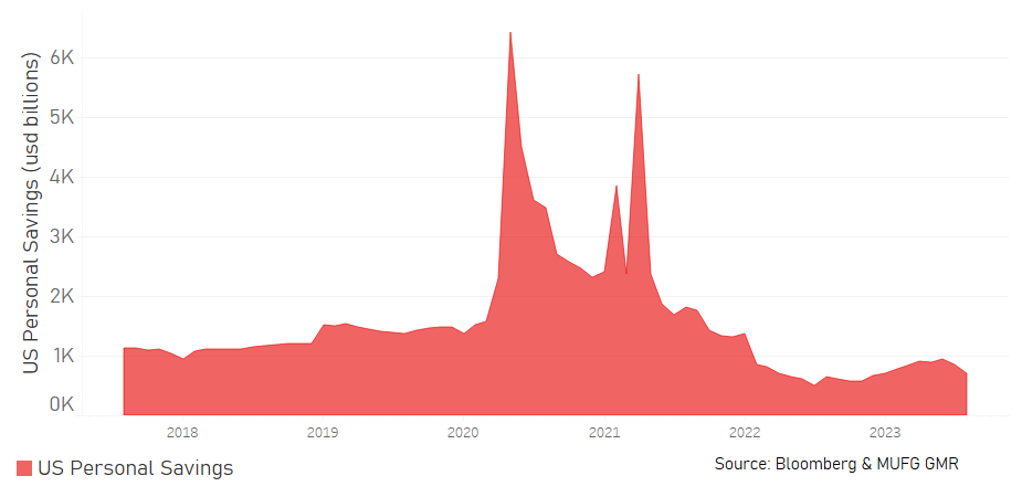
FED FUNDS RATE VS. 10YR UST YIELD
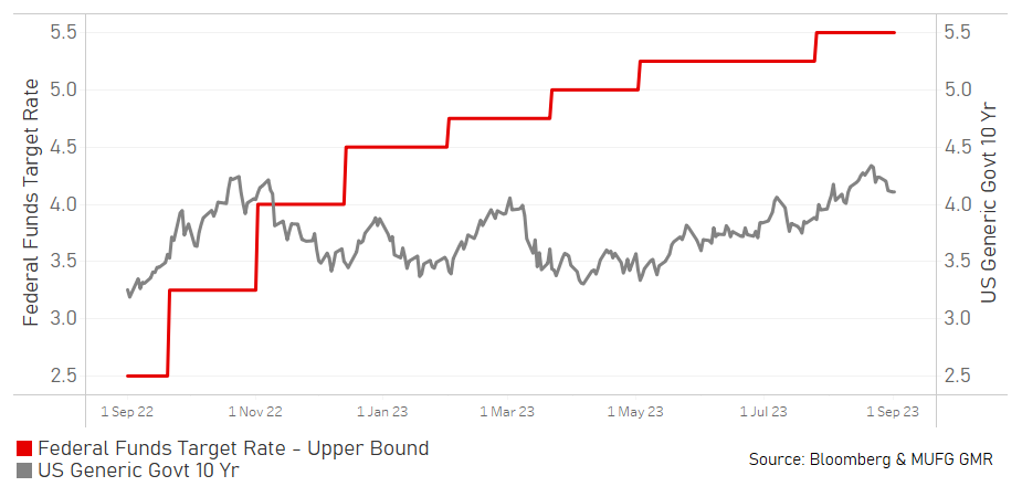
Japanese yen
|
Spot close 31.08.23 |
Q3 2023 |
Q4 2023 |
Q1 2024 |
Q2 2024 |
|
|
USD/JPY |
145.70 |
145.00 |
145.00 |
138.00 |
136.00 |
|
EUR/JPY |
158.00 |
155.20 |
156.60 |
151.80 |
152.30 |
|
Range |
Range |
Range |
Range |
||
|
USD/JPY |
140.00-151.00 |
138.00-152.00 |
132.00-148.00 |
130.00-146.00 |
|
|
EUR/JPY |
153.00-164.00 |
151.00-163.00 |
145.00-159.00 |
143.00-157.00 |
MARKET UPDATE
In August the yen weakened versus the US dollar in terms of London closing rates from 142.13 to 145.70. The yen weakened more marginally versus the euro, from 156.74 to 158.00. The BoJ did not meet in August and hence the monetary stance was unchanged with the BoJ continuing to allow 10-year JGB yields to fluctuate in the range of around +/- 0.5% from the target level of 0.0% but with these upper and lower bounds of the range being viewed now only as “references” and not “rigid limits” as was announced in July. Rigid limits now exist at +/-1.00%. In addition, the overnight policy rate remained unchanged at -0.1%.
OUTLOOK
The yen weakened in August with the YCC change announced at the end of July simply not enough to alter the negative yen momentum. While the YCC band was increased by 50bps to +/-1.00%, the BoJ’s expression of a desire to remain within the original +/-0.50% band clouded the outlook and fuelled uncertainty that limited the initial market reaction. The fact that the BoJ bought JGBs in the days following the decision limited the scope for the yen to appreciate. But the developments abroad also played a role in fuelling a higher USD/JPY. The data through most of August in the US was stronger than expected, which lifted short-term rates close to cyclical highs. US yields did correct toward month-end which we believe could be a sign of a turn in yields that points to downside risks for USD/JPY.
But we still believe the YCC change is an indication of BoJ plans to gradually move away from the framework and that further steps will be taken going forward. That could then be followed by a move away from the negative short-term policy rate. Of course certain factors will need to play out for the removal of negative rates and may take longer but at this juncture we pencil in possibly January 2024 as the next point of change for YCC. While global growth could well decelerate over this period as China remains weak and the US slows, there is an underlying shift to the inflation backdrop that will encourage further changes. BoJ Policy Board member (and admittedly a known hawk), Naoki Tamura stated in August that the 2% inflation goal could be achieved in Q1 2024. Governor Ueda is more cautious but stated that inflation was a “bit below” the 2% goal. Full-time employee’s schedule wages on an annual basis slowed from 2.0% in May to 1.7% in June but still remains at levels not seen since1997 and close to what Governor Ueda has stated is required in order to be confident of achieving the 2% inflation goal.
The underlying flows for the yen have also improved. Japan recorded a goods trade surplus of JPY 329bn in June – the first since October 2021 as energy price rises reverse. The reversal of this huge terms of trade shock could equate to about 2.0% of GDP over time. This is not helping the yen at present given the rising yields globally. But once yields turn lower globally, the prospects for the yen will improve and we see a notable JPY recovery in H1 2024.
INTEREST RATE OUTLOOK
|
Interest Rate Close |
Q3 2023 |
Q4 2023 |
Q1 2024 |
Q2 2024 |
|
|
Policy Rate |
-0.10% |
-0.10% |
-0.10% |
-0.10% |
0.10% |
|
3-Month Bill |
-0.30% |
-0.10% |
-0.08% |
0.00% |
0.10% |
|
10-Year Yield |
0.65% |
0.70% |
0.80% |
0.90% |
0.90% |
* Interest rate assumptions incorporated into MUFG foreign exchange forecasts.
The 10-year JGB yield increased modestly further in August, by 4bps to close at 0.65% and followed a much sharper move higher of 21bps after the BoJ widened the permitted trading band by 50bps to +/-1.00%. There was a bigger move higher in US Treasury 10yr yields underlining the continued containment of JGB yields given the threat of BoJ purchases to limit the move in yields. The BoJ actively bought JGBs but the fixed-rate unlimited purchase offers were met with no interest by the market during August after one such auction on the day of the YCC change at the end of July. The yen is now back at levels that previously prompted intervention and now with JGB yields with scope to move more, we may see the BoJ allow 10yr JGB yields to rise closer to 1.00% to try and limit yen selling. This scenario is plausible if UST bond yields rise further over the coming months. That is clearly the short-term risk but beyond then, we see JGB yields stabilising and upward pressure diminishing as yields globally fall. But with the BoJ moving away from a negative policy rate we believe in Q2 2024, the 10-year JGB is unlikely to fall back with global yields.
JAPAN LABOUR STATISTICS - EARNINGS YOY
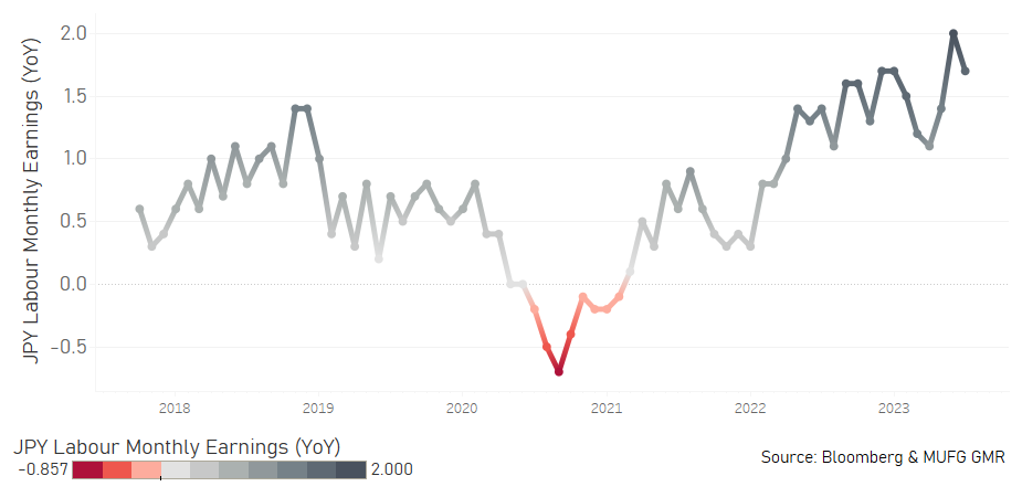
JAPAN BALANCE OF PAYMENTS TRADE BALANCE
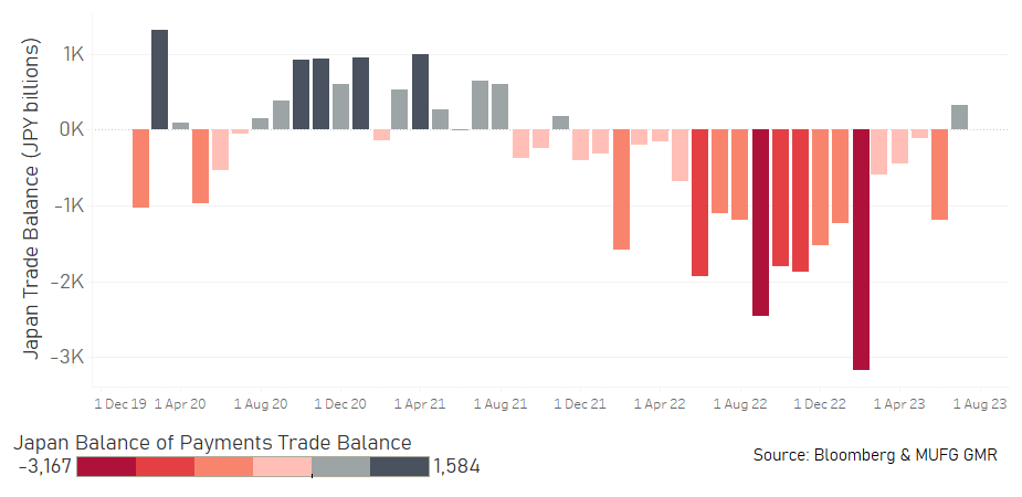
Euro
|
Spot close 31.08.23 |
Q3 2023 |
Q4 2023 |
Q1 2024 |
Q2 2024 |
|
|
EUR/USD |
1.0844 |
1.0700 |
1.0800 |
1.1000 |
1.1200 |
|
EUR/JPY |
158.00 |
155.20 |
156.60 |
151.80 |
152.30 |
|
Range |
Range |
Range |
Range |
||
|
EUR/USD |
1.0500-1.1200 |
1.0500-1.1300 |
1.0600-1.1400 |
1.0700-1.1600 |
|
|
EUR/JPY |
153.00-164.00 |
151.00-163.00 |
145.00-159.00 |
143.00-157.00 |
MARKET UPDATE
In August the euro weakened versus the US dollar in terms of London closing rates, moving from 1.1028 to 1.0844. The ECB did not meet in August and hence the key policy rate was unchanged at 3.75%, following the 25bp hike in July taking the cumulative tightening to 425bps. The ECB has now halted APP reinvestments, and increased the pace of QT to around EUR25 billion per month. In addition, the ECB announced its intention "to set the remuneration of minimum reserves at 0%”.
OUTLOOK
We stated here last month that the EUR was possibly breaking into a new trading range having breached decisively above the 1.1000 level in July. However, EUR/USD has failed to consolidate at those higher levels in part due to the rise in US yields relative to the euro-zone due to the continued resilience of the US economy. The macro backdrop in the euro-zone has not been particularly conducive for currency appreciation and the advance PMI reports in particular highlighted the fact that the manufacturing sector remains mired in recessionary conditions. The PMI manufacturing reading at 39.1 is consistent with conditions during COVID and the GFC. Companies locked into higher energy contracts and/or struggling with still high prices are likely factors weighing on activity. The renewed downturn in services activities now means recession will return to Germany. Euro-zone GDP after expanding by 0.3% Q/Q in Q2 could now contract again. In August the German government decided against subsidising electricity prices for German industry which could mean weak manufacturing activity persists going forward, especially if natural gas prices start to move higher, say in circumstances of colder than usual winter.
The ECB certainly appears more mindful of weaker economic growth and the strong bias to tighten has diminished as economic growth has failed to rebound since natural gas prices declined. Higher advance estimates of inflation in the euro-zone for August (5.3% YoY vs 5.1% expected) means the ECB decision on hiking again is finely balanced. Rhetoric from some known hawks on the Governing Council leans us to assume a pause in September. Executive Board member Isabel Schnabel was reserved in comments at the end of August and admitted that growth was weaker than assumed in June. There was certainly no push for additional hikes. The minutes of the July meeting revealed that all members agreed with the 25bp hike although there had been an initial discussion on not hiking rates at all. However, it was agreed that in the context of increased stagflation risks, not tightening enough was a greater risk. Still, with M3 money supply now contracting on an annual basis (-0.4%) tighter financial conditions could now offer the ECB some greater flexibility to pause.
The worsening growth outlook and the pushing back of the timing on US recession means we have lowered our EUR/USD levels (3-4 big figures) in Q3 and Q4 but still expect higher levels in H1 2024. Our levels assume no big increase in energy prices this winter which we acknowledge remains a key near-term downside risk.
INTEREST RATE OUTLOOK
|
Interest Rate Close |
Q3 2023 |
Q4 2023 |
Q1 2024 |
Q2 2024 |
|
|
Policy Rate |
3.75% |
3.75% |
3.75% |
3.75% |
3.50% |
|
3-Month Bill |
3.65% |
3.65% |
3.65% |
3.60% |
3.30% |
|
10-Year Yield |
2.47% |
2.50% |
2.40% |
2.30% |
2.20% |
* Interest rate assumptions incorporated into MUFG foreign exchange forecasts.
The 10-year German bund yield ended August close to unchanged from end-July, falling just 2bps to close at 2.47%. That close followed a move higher in yields in August but this then fully reversed. With the ECB set to pause its tightening cycle in our view and given the weak economic backdrop and the established trend of disinflation, we assume from here that the 10-year German yield can decline. The 5yr-5yr inflation swap rate declined by 13bps from the high in August, the biggest correction (closing basis) since the US regional banking sector turmoil in March. This will reassure the ECB that there is potential scope at least for a pause to assess the monetary tightening to date. But any pause would coincide with a message that more tightening may be needed. Euro-zone CPI in August was stronger than expected while food inflation risks globally have risen of late following the collapse of the Ukraine grain deal with Russia, India’s decision to ban exports of non-basmati rice and risks associated with El Nino. With natural gas prices more volatile of late, inflation risks will remain elevated, limiting the scale of decline in 10yr Bund yields.
EUROZONE SERVICES PMI SURVEY
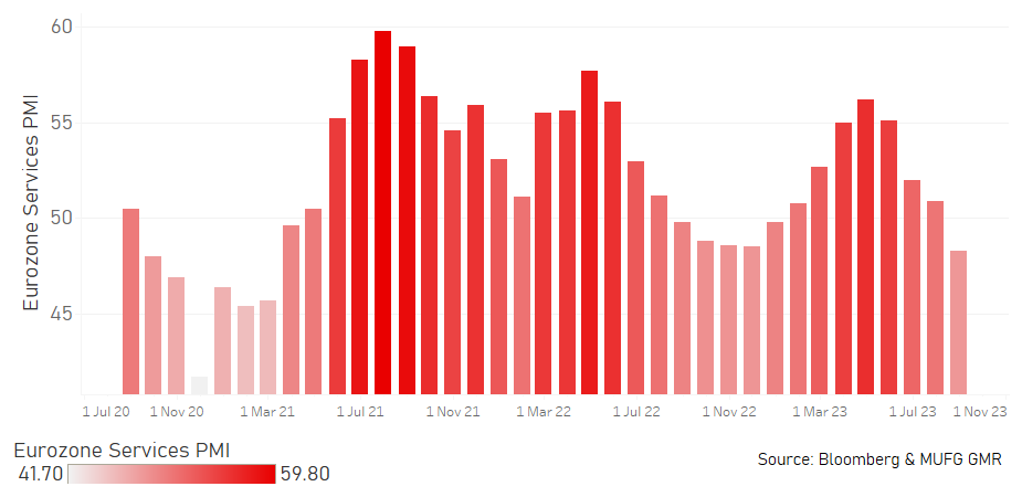
EURO AREA GDP GROWTH QOQ
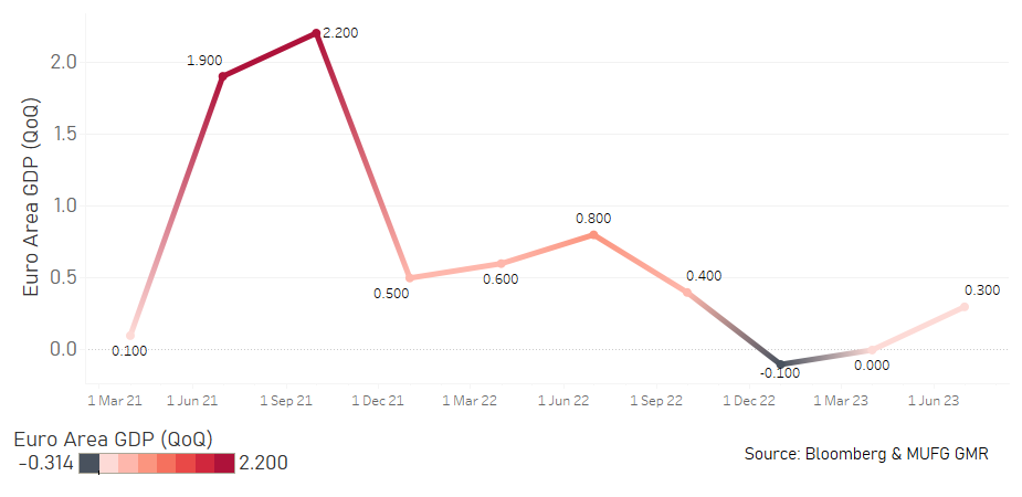
Pound Sterling
|
Spot close 31.08.23 |
Q3 2023 |
Q4 2023 |
Q1 2024 |
Q2 2024 |
|
|
EUR/GBP |
0.8561 |
0.8550 |
0.8650 |
0.8700 |
0.8850 |
|
GBP/USD |
1.2667 |
1.2510 |
1.2490 |
1.2640 |
1.2660 |
|
GBP/JPY |
184.56 |
181.50 |
181.00 |
174.50 |
172.10 |
|
Range |
Range |
Range |
Range |
||
|
GBP/USD |
1.2300-1.3100 |
1.2200-1.3200 |
1.2100-1.3300 |
1.2000-1.3400 |
MARKET UPDATE
In August the pound weakened against the US dollar in terms of London closing rates from 1.2864 to 1.2667. The pound strengthened very marginally against the euro, from 0.8573 to 0.8561. The BoE at its policy meeting in August raised the key policy rate by 25bps to 5.25%, the 14th consecutive rate increase. The hike was not unanimous with a split vote (6-2-1) with two voting for 50bps and one for no change.
OUTLOOK
The pound weakened versus the US dollar, was broadly stable versus the euro and outperformed most other G10 currencies with yield playing a role in that outperformance. The UK is the one market within G10 where there is substantially more than one further rate hike priced. The OIS market implies between two further 25bp rate hikes are expected. This expectation was helped in part by the BoE policy meeting on 3rd August when the guidance was largely consistent with the probable need of more hikes. The key guidance in the statement was maintained that “If there were to be evidence of more persistent pressures, then further tightening in monetary policy would be required”. Until that guidance is altered or until we see a much more compelling turn in inflation risks, the BoE will lean hawkishly. We are maintaining our view of one further 25bp rate increase at the meeting in September to 5.50% but the risk is skewed that the BoE may need to raise the key policy rate again in November to 5.75%. We believe BoE Chief Economist Huw Pill’s comments that he has a preference for a “table-mountain” of rates being at a level where it can remain for longer as a sign of a potential consensus building for a pause.
The economic data following the BoE meeting in August were generally stronger than expected. GDP expanded by 0.2% Q/Q in Q2 while CPI data was a touch stronger but wage growth was a lot stronger than expected. The 3mth YoY total wage growth accelerated from 7.2% to 8.2% - the highest since July 2021 while the ex-bonus measure surged from 7.5% to 7.8% - a new record high. Labour supply issues unique to the UK are clearly impacting wages. No other G10 country has record wage growth at this juncture with peak growth having already passed. The departure of EU workers after Brexit and/or COVID and a record total of those unwilling to work due to long-term sickness have resulted in a much tighter labour market. NHS patient waiting lists have moved to over 7mn in the UK and a slow process in issuing work visas have added to the tightness. Still, we suspect that after one more hike, the BoE will become more willing to allow time for the monetary policy transmission to work. The tone of rhetoric in August suggest a greater focus on growth going forward.
GBP is currently deriving support from the tightening ahead priced into the OIS curve. However, the BoE will need to pause soon to assess the extent of tightening to date and that is likely to happen sooner than expected, which will see GBP underperform. Flat growth / mild recessionary conditions will weigh on GBP also.
INTEREST RATE OUTLOOK
|
Interest Rate Close |
Q3 2023 |
Q4 2023 |
Q1 2024 |
Q2 2024 |
|
|
Policy Rate |
5.25% |
5.50% |
5.50% |
5.50% |
5.00% |
|
1-Year Yield |
5.17% |
5.20% |
5.00% |
4.80% |
4.50% |
|
10-Year Yield |
4.36% |
4.40% |
4.30% |
4.20% |
4.00% |
* Interest rate assumptions incorporated into MUFG foreign exchange forecasts.
The 10-year Gilt yield increased in July, by 5bps to close at 4.36%. Like elsewhere yields initially jumped by more but then corrected into month-end as UST bond yields corrected lower. The transmission of monetary policy to the real economy is likely taking longer in this cycle given the far higher fixed rate mortgages, which account for over 80% of the entire market. According to the BoE over 700k mortgages reset in Q2 and Q3 2023 with the majority of those mortgages resetting from fixed rates less than 2.5%. M4 money supply growth data also highlights the increasing impact of higher interest rates. The YoY growth in M4 money supply contracted by 0.9% in July after a 0.1% gain in June. It was the largest contraction in M4 money supply since February 2015. These developments should reassure the BoE and with inflation set to halve by end-2023 to 4.9%, the point of pausing to assess the impact of monetary tightening is approaching. Continued disappointing GDP growth, contracting broad money supply, tightening lending conditions in the housing market and a fall in global yields should all work to lowering 10yr Gilt yields through the forecast horizon.
UK GDP GROWTH QOQ
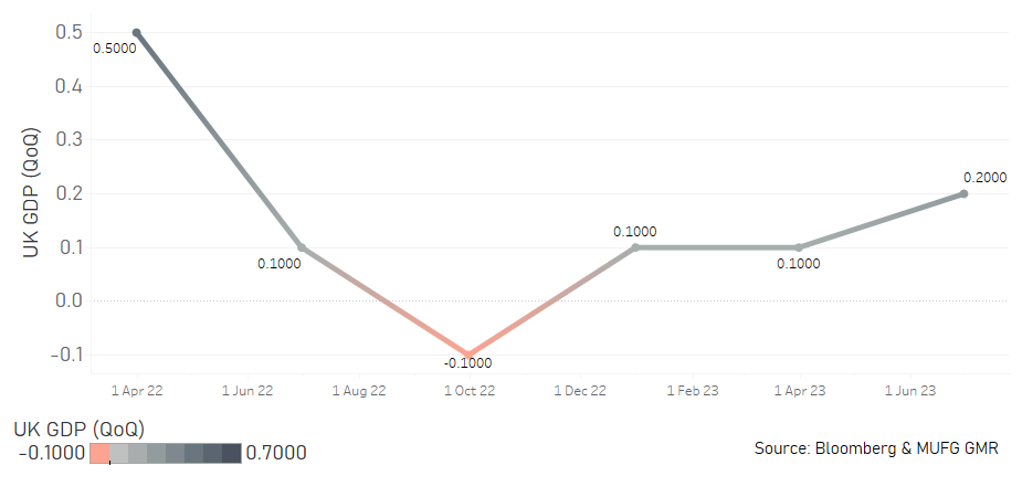
UK WEEKLY EARNINGS YOY
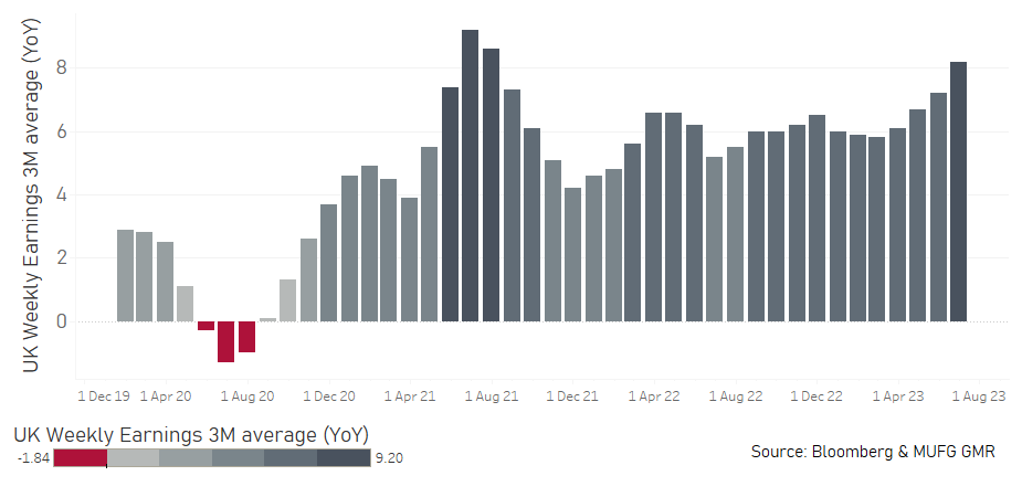
Chinese renminbi
|
Spot close 31.08.23 |
Q3 2023 |
Q4 2023 |
Q1 2024 |
Q2 2024 |
|
|
USD/CNY |
7.2583 |
7.2000 |
7.1000 |
6.9000 |
6.8000 |
|
USD/HKD |
7.8429 |
7.8400 |
7.8300 |
7.8200 |
7.8100 |
|
Range |
Range |
Range |
Range |
||
|
USD/CNY |
7.0000-7.3500 |
7.0000-7.3500 |
6.8500-7.2500 |
6.7500-7.1500 |
|
|
USD/HKD |
7.7600-7.8400 |
7.7500-7.8300 |
7.7400-7.8200 |
7.7400-7.8200 |
MARKET UPDATE
In August, the Chinese yuan depreciated by 1.6% against the US dollar to 7.2583. The PBOC cut rates on 15th August, lowering 1-year medium-term lending facility rate by 15bps to 2.50% and 7-day repo rate by 10bps to 1.80%, and reducing overnight, 7-day and 1-month standing lending facility rates by 10bps each to 2.65%, 2.80% and 3.15% respectively. That said, the PBOC surprised market on 21st August, with a modest 10bps cut on 1-year LPR while keeping the 5-year LPR unchanged at 4.20%.
OUTLOOK
The yuan sentiment deteriorated in August amid increasing concerns on China’s real estate sector and economic performance. Headline year-over-year growth in Chinese key macro data for July, including IP, retail sales, FAI and property investment, surprised to the downside and were down from their values in June, and month-over-month changes of these indicators all deteriorated. Northbound stock connect recorded a net selling totalling more than USD 11.2bn in August, the largest monthly selloff on record. In view of that, Chinese authorities stepped up its efforts last month to support the yuan by various measures including USD/CNY fixing guidance and adjusting offshore yuan liquidity. On 22nd August, the CFETS USD/CNY fixing set by the PBOC was 1111pips lower relative to Bloomberg CNY fixing survey, and the gaps stayed around a sizeable 900pips in the second half of August.
China’s yuan is in a delicate position, as the government tries to stabilize it while cutting policy rates at the same time. With the expectation of the US policy rate staying higher for longer, the stretched negative yield spread between China and the U.S. keeps the long USD/CNY carry trade attractive. China just released its August PMIs, the still below manufacturing PMI (49.7) and a drop in the non-manufacturing PMI in August indicated probably another set of weak economic data for August (to be released on 15th September). Having said it, for our updated monthly view, we still maintain a moderate bearish view on USD/CNY towards the end of September, as market sentiment may improve slightly and may compensate the drag on the CNY brought by the negative yield spread and still weak economic data. The fact, that stock prices of some Chinese developers listed in Hong Kong rebounded more than 10% during last week, implies a possible turnaround of sentiment, should more policies or pledges be delivered by the government. Recently, Chinese governments delivered important policy guidelines: PBOC, National Financial Regulatory Administration and CSRC on 18th August called for adjusting credit policy for the real estate sector; PBOC, Ministry of Housing and Urban-Rural Development and National Financial Regulatory Administration on 25th August announced to further ease mortgage policies; and the policy of “Recognizing the house but not the loan” was proposed to stimulate the housing demand. We expect details of these policies to follow in near term, and expect USD/CNY to reach 7.2000 by the end of Q3 and reach 7.1000 by the end of this year.
INTEREST RATE OUTLOOK
|
Interest Rate Close |
Q3 2023 |
Q4 2023 |
Q1 2024 |
Q2 2024 |
|
|
Loan Prime Rate 1Y |
3.45% |
3.35% |
3.25% |
3.35% |
3.45% |
|
MLF 1Y |
2.50% |
2.40% |
2.30% |
2.40% |
2.50% |
|
7-Day Repo Rate |
1.80% |
1.70% |
1.60% |
1.70% |
1.80% |
|
10-Year Yield |
2.58% |
2.50% |
2.55% |
2.65% |
2.75% |
* Interest rate assumptions incorporated into MUFG foreign exchange forecasts.
China’s 10-year government bond yield declined sharply by 12bps from 2.66% on 11th August to 2.54% on 21st August. From a macro perspective, as the PBOC continues to maintain an easing stance ahead and likely further cuts policy rates near-term, loan rates and deposit rates will remain on a downward path, overall bond rates and money market rates will likely display similar patterns. There exists a situation of under-allocation of bonds in banks' self-operated on-balance sheet investment, the potential of stronger demand for bonds by banks could also stress on government bond yield. As of bond supply, CICC estimated that the net increase in government bonds from August to December may be about 3-3.5 trillion yuan, a level smaller than the potential allocation increase of around 3.7 trillion yuan on government bonds on banks' balance sheets. The issuance of special refinancing bonds and the moderate increase in sentiment may provide support for higher yields but would unlikely derail the government bond yield from its declining path. We expect the 10-year bond yield to reach 2.50% by the end of Q3.
CHINA’S ECONOMIC ACTIVITIES REMAINED WEAK IN JULY
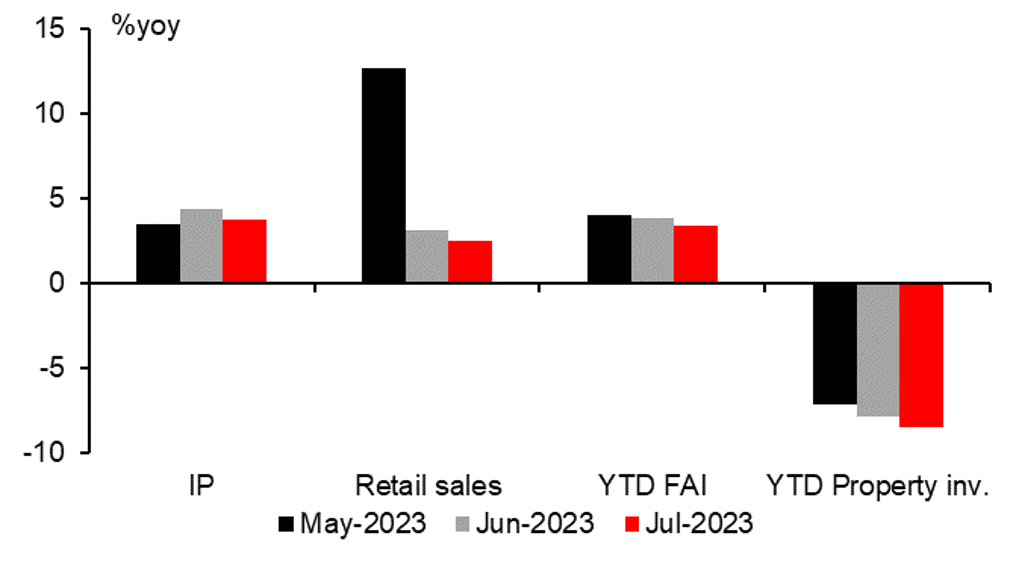
Source: CEIC, MUFG GMR
PBOC CUT POLICY RATES LAST MONTH
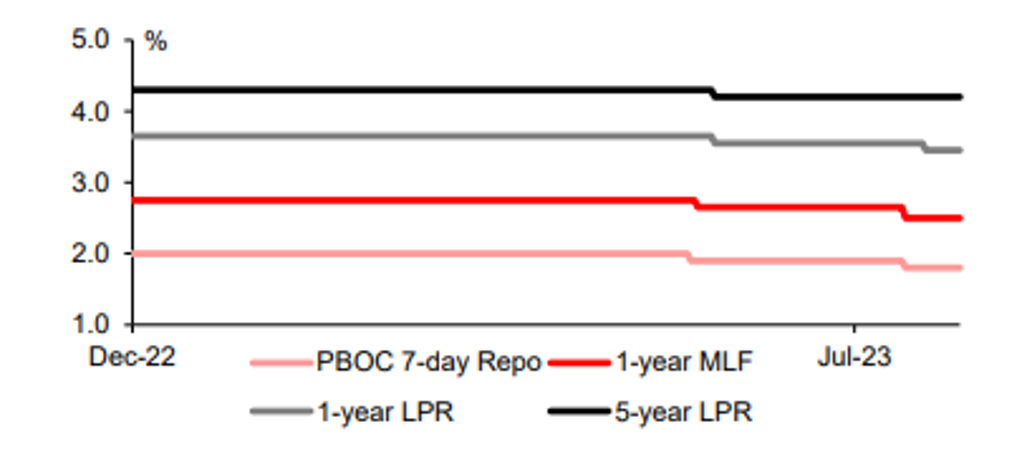
Source: Bloomberg, MUFG GMR



